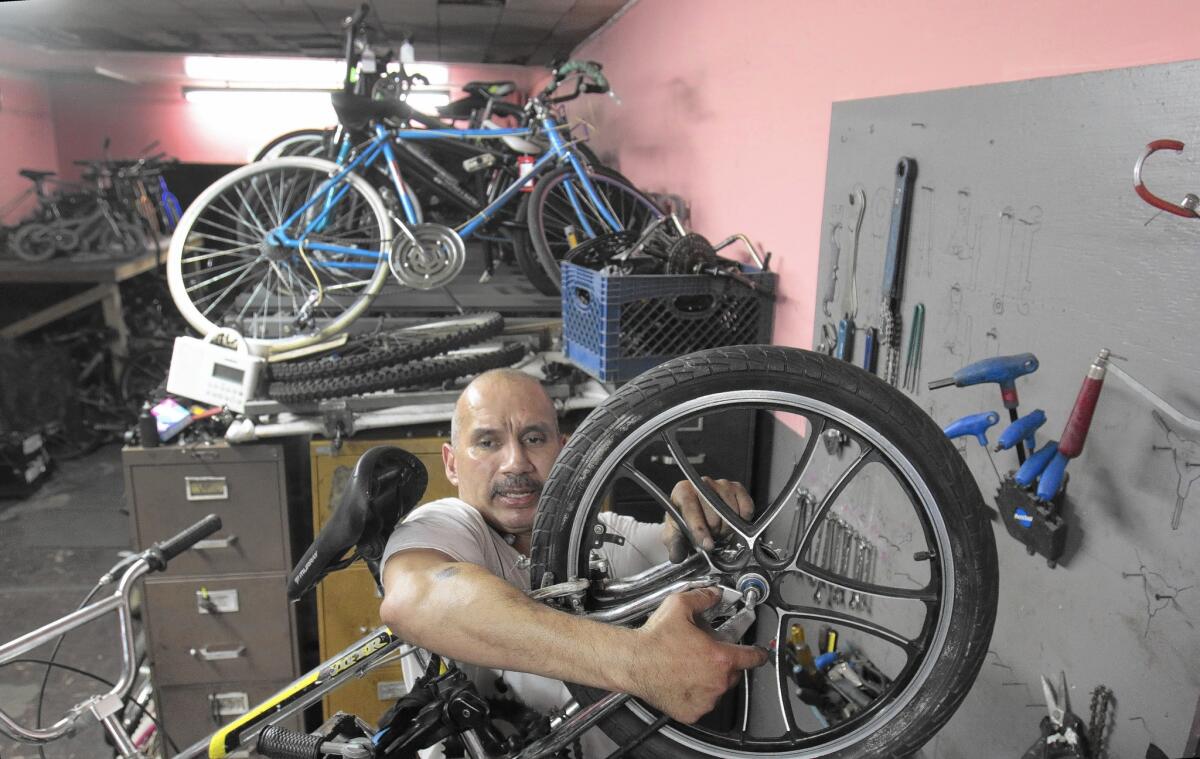Will CicLAvia bring buy-cyclists to a wary Eastside?

- Share via
Soon the cyclists will come by the thousands. This much Magdalena De La Torre knows.
What’s not so clear is how all these visitors will affect her family’s market and other local businesses.
“Are they going to ride in, have their fun and never return?” De La Torre asked. “Or will they stop and support the neighborhood?”
It’s a question many in Boyle Heights and East Los Angeles are asking as CicLAvia, the city’s largest cycling-centric event, prepares to take over the streets Oct. 5. More than 50,000 people are expected to pour in on bicycles, skateboards and on foot.
While other areas lobby to bring the popular event to their part of town, the Eastside has expressed mixed feelings. Some see CicLAvia as a boon for business, a great way to share the Latino heart of L.A. with those who rarely explore life east of the river.
Others worry that rolling out the welcome mat to cyclists will only speed up the gentrification that’s been inching its way in from downtown in recent years.
“Our concern is not about that day,” said Erendira “Endy” Bernal of the Maravilla Businesspersons Assn., which covers a redevelopment zone in East L.A. “It’s about the ripple effect that could come after from people who have the mentality of expanding here to make profit.”
Murmurs of change have been heard for some time in Boyle Heights.
Guisados Tacos already draws crowds of downtowners and tourists to Cesar E. Chavez Avenue. Soon, an upscale bakery will open on 1st Street; a gallery owned by an out-of-state artist is also on the drawing board.
But much of the recent angst was triggered in late spring, when a downtown real estate flier went up promoting a 60-minute bicycle tour of the area.
The outing was aimed at young adults looking to buy cheap. “Why rent downtown when you can own in Boyle Heights?” the poster read, touting the area as “charming, historic, walkable, bikeable.”
In the end, there was so much backlash from the community that the event was canceled. But it left residents wary, and talking — among other things — about bike-friendliness and how it might entice outsiders to swoop in and transform the area.
When cycling lanes were added on 1st Street a few years ago, there was no sense of public disapproval. There was also not much said the other six times CicLAvia rode a few miles into Boyle Heights.
But Los Angeles has plans to add 3.6 more miles of bicycle lanes on Soto Street and a few on Boyle Avenue. And this time around, CicLAvia’s 10-mile path will cut all the way into East L.A.
Several business owners — including Rosanna Esparza Ahrens, a lifetime East L.A. resident — were part of recent CicLAvia meetings. They asked officials to be sensitive and inclusive of the neighborhood.
“I want our community to be informed and participate, not just stand by as observers wondering where all these Westside people came from,” Esparza Ahrens said.
The artist said she initially was apprehensive about the event, considering it a “hipster invasion.” But she’s since learned that it’s family-friendly and is now looking forward to it.
Others like Jesus Huerta, who owns three businesses along the route, including the well-known El Gallo Bakery, said his only concern was being informed about street closures, schedules and customer access on the day of the ride.
“If you’re going to come into my backyard and host a barbecue, you’re going to need to lay out every last detail for me,” he said.
Officials with CicLAvia spent weeks knocking on doors, notifying the community about the ride. They said the vast majority of participants probably would be residents who live along the Eastside route.
“Once people see that the event is something that will feel like East L.A. and will represent East L.A.,” said Aaron Paley, CicLAvia’s executive director, “then they will understand that this is an event that works for them, not against them.”
The Eastside has a long history of cycling, from low-income riders who can’t afford cars to neighborhood kids cruising for fun to organized groups riding for a cause.
Many in the cycling community welcome any bike-friendly improvements, and argue that gentrification doesn’t have anything to do with cycling.
“This is an issue that has to do with housing values and business,” said Andy Rodriguez, board member of Multicultural Communities for Mobility, an advocate for low-income riders. “Cycling, unfortunately, just got tangled into that conversation.”
On Cesar E. Chavez Avenue, many shopkeepers seemed lukewarm about the soon-to-be visitors.
De La Torre, of Carnitas Uruapan Market, hopes the riders will come thirsty for her water and soda. Miguel Orozco, who manages a discount store of clothes and housewares, doesn’t expect sales, just a few looky-loos.
And David Mejia, owner of Botanica La Santa Cruz, doesn’t plan to open that day. He thinks cyclists won’t care much for his wife’s spiritual cleansings and card readings.
“You already know where they’re all going to line up and spend their money,” Mejia said. “Three doors down at Guisados.”
esmeralda.bermudez@latimes.com
Twitter: @LATbermudez
More to Read
Sign up for Essential California
The most important California stories and recommendations in your inbox every morning.
You may occasionally receive promotional content from the Los Angeles Times.











